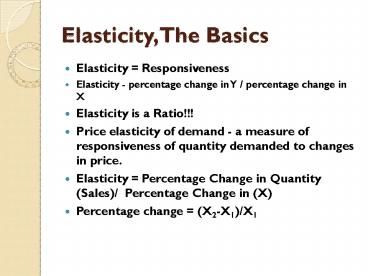Elasticity, The Basics - PowerPoint PPT Presentation
1 / 25
Title:
Elasticity, The Basics
Description:
Elasticity, The Basics Elasticity = Responsiveness Elasticity - percentage change in Y / percentage change in X Elasticity is a Ratio!!! Price elasticity of demand ... – PowerPoint PPT presentation
Number of Views:163
Avg rating:3.0/5.0
Title: Elasticity, The Basics
1
Elasticity, The Basics
- Elasticity Responsiveness
- Elasticity - percentage change in Y / percentage
change in X - Elasticity is a Ratio!!!
- Price elasticity of demand - a measure of
responsiveness of quantity demanded to changes in
price. - Elasticity Percentage Change in Quantity
(Sales)/ Percentage Change in (X) - Percentage change (X2-X1)/X1
2
The Point Formula
- ((Q2-Q1)/Q1) / ((P2-P1)/P1)
- Problems
- Order of events dictate outcomes
- Does not impose ceteris paribus.
3
The Arc Formula
- ((Q2-Q1)/(Avg.Q) / ((P2-P1)/(Avg.P)
- Problem
- 1. Does not impose ceteris paribus
4
The Slope Formula
- Elasticity
- ?Q / ?P ((Q2-Q1)/Q1) / ((P2-P1)/P1)
- Note Q2-Q1 ?Q and P2-P1 ?P
- Therefore Elasticity ?Q /Q / ?P/P
- Note If you divide by a fraction you multiply
by the reciprocal. - Therefore Elasticity ?Q /Q P/?P
- or Elasticity ?Q / ?P P/Q
- Where do we get ?Q / ?P?
- This is the inverse slope of the demand curve,
which we can estimate empirically (via basic
econometrics), and therefore we can impose
ceteris paribus.
5
Interpretation of Price Elasticity
- change in Q gt change in P
- (elastic or responsive) Ep gt 1
- change in Q lt change in P
- (inelastic or unresponsive) Ep lt 1
- change in Q change in P
- (unitary elastic) Ep 1
6
Next 10 slides are from Colander (2003)
7
Elasticity Is Not the Same as Slope
- The steeper the curve at a given point, the less
elastic is supply or demand. - There are two limiting examples of this.
8
Elasticity Is Not the Same as Slope
- When the curves are flat, we call the curves
perfectly elastic.
- The quantity changes enormously in response to a
proportional change in price (E ).
9
Elasticity Is Not the Same as Slope
- When the curves are vertical, we call the curves
perfectly inelastic.
- The quantity does not change at all in response
to an enormous proportional change in price (E
0).
10
Perfectly Inelastic Demand Curve
11
Perfectly Elastic Demand Curve
12
Elasticity Changes Along Straight-Line Curves
- Elasticity is not the same as slope.
- Elasticity changes along straight line supply and
demand curvesslope does not.
13
Elasticity Changes Along Straight-Line Curves
- On a demand curve, elasticity is perfectly
elastic (E ) at the price intercept.
- It becomes smaller as you move down the demand
curve until it becomes zero at the quantity
intercept.
14
Elasticity Changes Along Straight-Line Curves
- Elasticity is perfectly elastic (ES ) where a
straight line supply curve intercepts the price
axis.
- Points become less elastic as you move out along
the supply curve.
15
Elasticity Changes Along Straight-Line Curves
- Elasticity is perfectly inelastic (ES 0) where
a straight line supply curve intercepts the
quantity axis.
- Points become more elastic as you move out along
the supply curve.
16
Elasticity Along a Demand Curve
Elasticity declines along demand curve as we move
toward the quantity axis
17
Total Revenue and Elasticity
- Total Revenue Price Quantity Total dollar
value of units sold - If change in Q gt change in P decreasing the
price will increase TR - If change in Q lt change in P increasing the
price will increase TR
18
Profit and Elasticity
- Profit Total Revenue - Total Cost
- If demand is inelastic (i.e. change in Q lt
change in P) an increase in price will increase
TR. - Because Q falls (law of demand), so too will
Total Cost - Why? Total Cost (which we will discuss later) is
an increasing function of output. The more you
produce, the higher your total cost. - Consequently, if demand is inelastic, a firm can
raise its price and increase its profits.
19
Summarizing Demand
- The Law of Demand - Quantity demanded rises as
price falls, ceteris paribus. Quantity demanded
falls as price rises, ceteris paribus - The Law of Demand is based upon Gossens First
and Second Laws. - The Law of Demand gives us the Demand Curve
- Via own-price elasticity, we move from the demand
curve to total revenue. - Total Revenue Price Quantity
- Without own-price elasticity we do not know how
changes in price and quantity will impact total
revenue. - The variation in total revenue gives us the
concept of marginal revenue.
20
Marginal Revenue
- Marginal Revenue - amount of revenue from the
last unit sold. - the rate of change in total revenue
- the slope of the total revenue curve.
- If demand is downward sloping, then price will
exceed marginal revenue. In other words, the
amount of revenue generated by an additional sale
will be less than the price the firm charges. - Why? To increase quantity the firm will need to
lower the price, not just for the last unit sold,
but also for every unit the firm wishes to sell.
21
Determinants of the price elasticity of demand
- Determinants of price elasticity of
demand Substitutes and Elasticity - Time
- Necessity vs. Luxury
- More specific the good the more elastic demand
- Price of the good relative to income
22
Short-Run and Long-Run Elasticities of Demand
23
Other Elasticity Concepts
- Cross price elasticity of demand
- change in quantity / change in the
- price of another good
- Income elasticity
- change in quantity / change in income
24
Income Elasticities of Selected Goods
25
Cross-Price Elasticities































